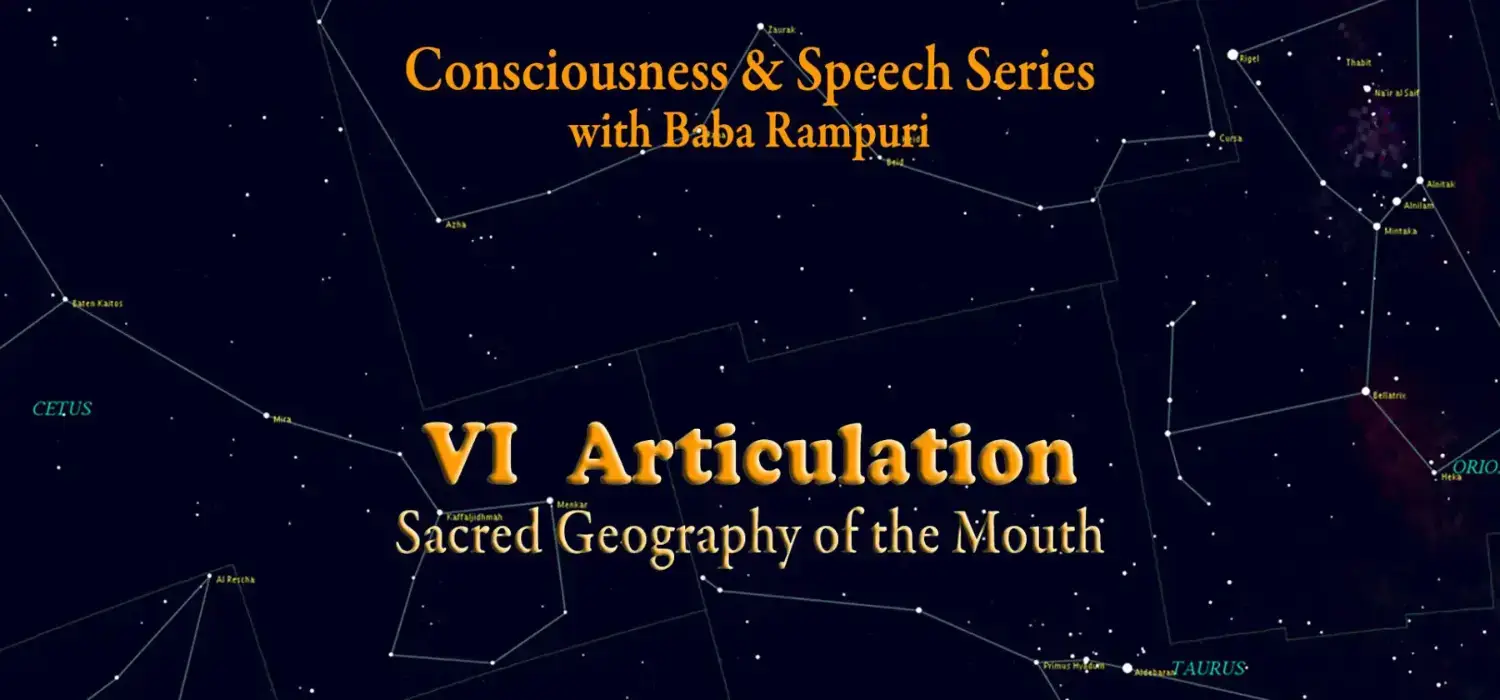
Sacred Geography of the Mouth part 2
Sacred Speech Masterclass episode VI
part 2 of 5 parts
hosted by Baba Rampuri
![]()
Articulation
And therefore, the syllable “a” is the syllable of Shiva. It’s the syllable of consciousness. Therefore, we call it anuttara, that which there is nothing greater.
![]()

![]()
There are five stations of articulation starting with the throat. And I will name these stations with the syllables that begin what is called a varga. So, the first station is in the throat and it is “Ka” varga. If you will all pronounce articulate “Ka.” Can you say, “Ka?” I can’t hear you because you are all muted, but that’s cool. [Some participants unmated themselves and started to pronounce, “Ka.”] Maybe you should all un-mute yourselves so I can hear you. Put your fingers on your throat when you say that. “Ka.”
Now what we are going to is we’re going to move up one level. We are going to pronounce “Cha” [participants start to say ‘cha’] . Can you feel how you have moved from one space to another space? You have moved up. Think of the vocal apparatus as dome. We are going to define that dome now. We are going to start at “Ka.” Then we move up one to “Cha.”
Now for the third I want you to put the tip of your tongue to the roof of your mouth and say, “ṭa.” OK. Don’t put your tongue against your teeth. You put your tongue straight up. This is very, very important. “ṭa.” Now I want you to pronounce the same thing, except with the tongue touching your teeth. And now, the fifth one is your lips. “Pa.” “Pa.” “Pa.” Ok. So you can feel there are five places that you go to in your vocal apparatus. Ka. Cha. ṭa. Ta. Pa. You’ve all got that? This is important. I want you… Everything is going to be referenced from these stations. So it is important that you understand where these places are because also, in the end, I am not going to teach you how to make sounds. I am going teach you to how look for sounds in your mouth. Kailash, you wanted to say something.
Kailash: Yeh. I am hoping for a… Like for in number three, “Ta,” How do you usually represented that in writing?
Baba Rampuri: You mean in English transliteration?
Kailash: Exactly.
Baba Rampuri: OK. That’s usually with a dot underneath the “t” or the “d” or the nasal.
Michelle: Yea.
Baba Rampuri: OK.
Kailash: Thank you.
Kailash: And what of the sites. Can we go through the sites? I’ve got the throat at the beginning and the lips at the end, but kind of … I’ve got roof of the mouth, too, for number three.
Baba Rampuri: OK.
Kailash: What do you call that area between throat and roof of mouth. The Glottus?
Baba Rampuri: What is that called in English?
Kailash: Glottal?
Michelle: Palettal
Baba Rampuri: No, I think palet is the roof of the mouth. That’s called. What is that called? Is it veyler? Vehlum?
Michelle: Yes, that is one of the ways of saying it
Baba Rampuri: It will probably come to me as well
Baba Rampuri: So you see I don’t really think these are the important things. And you know, for your own personal notes, maybe, OK, but I don’t want you to put an emphasis on this- actually– even on your notes themselves — because this is an exercise in walking together on this, on exploring together and if we are successful in this then you will be able to discover all of the articulations all the mantras, the syllables, the matrikas. You will be able to discover them in your own mouth, rather than superimposing them on your mouth which is what I am trying to avoid. I want to avoid as much theory and ideology as possible and encourage as much exploration as possible.
Kailash: I just want a handle on things so we can discuss them.
Baba Rampuri: Absolutely. I am with you 100 % on that. I just want to issue a word of warning. That we sort of stay exploring instead of going off into some sort of thinking,
Kailash: Go it.
Baba Rampuri …Some sort of ideology mode.
Baba Rampuri: Ok. So we have issues of geography but we also have issues of aspiration, we have issues of contraction, and we have issues of direction of articulation. In other words, we have 4 columns, as it were, on each varga, on each line, which deal with issues of aspiration and of contraction of the throat. And then the fifth element, we send the articulation through our nose. So there are five syllables, which we call nasals, and these will be syllables that we will send through our nose instead of our mouth.
Let’s get to the vowels now, to start out with. And the most important of all vowels, in fact the most important of all the syllables, is the vowel, “a.”
The vowel “a” arises effortlessly from our chest, through our throat. It is marking the unmanifest. It’s marking that which is not in any way solid. It is, it’s what you might say if you’re trying to think of something or somebody’s name. You might say “uh…, what’s his name? uh…what is that word? ….” And, so, automatically, naturally, this “a” is at basis of all other articulation that is going to follow. All other articulation is arising out of the syllable, “a.”
And therefore, the syllable “a” is the syllable of Shiva. It’s the syllable of consciousness. Therefore, we call it anuttara, that which there is nothing greater. Ok?
Interestingly enough, in Indian languages and in Sanskrit , if we want to negate a word, we say “a” before the word.
So, “mrit” means death; “amrit” means immortality.
Uttara is the top, the greatest. Anunttara, means that which has nothing greater.
![]()